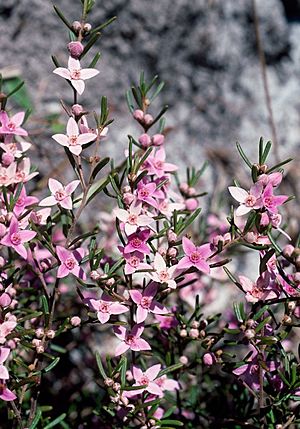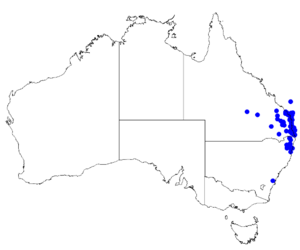Forest rose facts for kids
Quick facts for kids Forest boronia |
|
|---|---|
 |
|
| Boronia rosmarinifolia at Red Rock | |
| Scientific classification | |
 |
|
| Occurrence data from Australasian Virtual Herbarium |
The Boronia rosmarinifolia, also known as the forest rose, is a beautiful plant found only in eastern Australia. It belongs to the citrus family called Rutaceae. This plant is a shrub with many branches and simple leaves. It has pretty pale to bright pink flowers. These flowers grow one by one where the leaves meet the stem.
Contents
About the Forest Boronia
The forest boronia is a woody shrub that stands upright. It has many branches and can grow up to about 1 meter (3.3 feet) tall. Its leaves are simple and shaped like narrow lines or ovals. They are usually 6 to 30 millimeters (0.2 to 1.2 inches) long and 1.5 to 3 millimeters (0.06 to 0.12 inches) wide. The edges of the leaves are often curled downwards.
Flowers and Fruit
The flowers of the forest boronia are usually pale to bright pink. Sometimes, they can even be white. Each flower grows on a small stalk, about 2 to 7 millimeters (0.08 to 0.28 inches) long.
The flower has four hairy sepals. These are like small, leaf-like parts that protect the bud. They are egg-shaped or triangular and grow bigger as the fruit forms. There are also four petals, which are the colorful parts of the flower. They are about 5 to 7.5 millimeters (0.2 to 0.3 inches) long. Like the sepals, the petals also get larger as the fruit develops.
Inside the flower, there are eight stamens. These are the parts that produce pollen. They are different lengths, with some being longer than others. The flowering season for the forest boronia is from July to October. After flowering, the plant produces a fruit called a capsule. This capsule is usually smooth and measures about 4 to 5.5 millimeters (0.16 to 0.22 inches) long.
Naming the Forest Boronia
The Boronia rosmarinifolia was first described by a botanist named Alan Cunningham. His description was officially published in 1837 by Stephan Endlicher. Cunningham found the first sample of this plant on Peel Island in 1824.
The second part of its scientific name, rosmarinifolia, tells us something special about the plant. It comes from two Latin words: rosmarinus, which means "rosemary", and folium, which means "leaf". This name was chosen because the leaves of the forest boronia look a bit like rosemary leaves.
Where It Grows
The forest boronia grows in specific types of areas in eastern Australia. You can find it in sandy wallum heathlands and woodlands. These areas are between Bundaberg in Queensland and Grafton in New South Wales.
Conservation Status
Good news! The forest boronia is not currently in danger. The Queensland Government has classified it as "least concern" under their Nature Conservation Act 1992. This means there are enough of these plants in the wild, and they are not at risk of disappearing.

